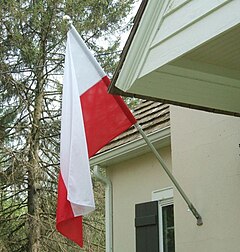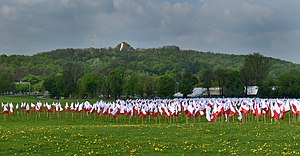
The national flag of Poland consists of two horizontal stripes of equal width, the upper one white and the lower one red. The two colours are defined in the Polish constitution as the national colours. A variant of the flag with the national coat of arms in the middle of the white fess is legally reserved for official use abroad and at sea. A similar flag with the addition of a white eagle is used as the naval ensign of Poland.

The Senate is the upper house of the Polish parliament, the lower house being the Sejm. The history of the Polish Senate stretches back over 500 years; it was one of the first constituent bodies of a bicameral parliament in Europe and existed without hiatus until the final partition of the Polish state in 1795. The contemporary Senate is composed of 100 senators elected by a universal ballot and is headed by the Marshal of the Senate. The incumbent Marshal of the Senate is Małgorzata Kidawa-Błońska.

The coat of arms of Poland is a white, crowned eagle with a golden beak and talons, on a red background.

The Constitution of the Republic of Poland is the supreme law of the Republic of Poland, which is also commonly called the Third Polish Republic in contrast with the preceding systems.
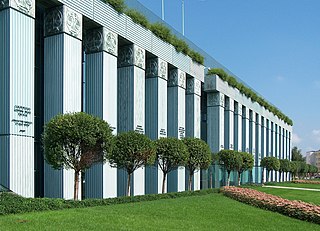
The Supreme Court is the highest court in the Republic of Poland. It is located in the Krasiński Square, Warsaw.
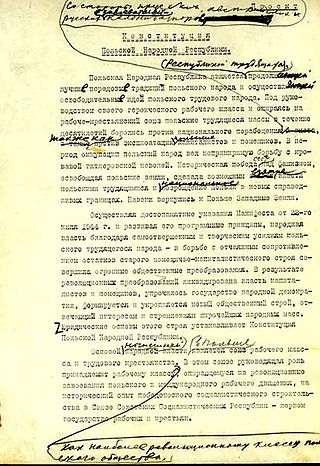
The Constitution of the Polish People's Republic was a supreme law passed in communist-ruled Poland on 22 July 1952. It superseded the post-World War II provisional Small Constitution of 1947, which in turn replaced the pre-war April Constitution of 1935.

Ministry of the Interior and Administration is an administration structure controlling main administration and security branches of the Polish government. After Parliamentary Election on 9 October 2011 was transformed for two ministries: Ministry of Interior and Ministry of Administration and Digitization. It was recreated in late 2015.

God, Honour, Fatherland or Honour and Fatherland is one of the unofficial mottos of Poland. It is commonly seen as the motto of the military of Poland, and has been confirmed as such by several Polish legal decrees.

Military eagles are military insignia used in the Polish Armed Forces, based on the White Eagle of the Polish coat of arms. They are used on elements of military uniforms such as hats and buttons, as well as on military banners, flags, medals, emblems, publications etc. One variant exists for each of the five branches of the Armed Forces. Additionally, the Minister of National Defence, the Marshal of Poland, and generals and admirals use their own variants.
National symbols of Poland are the tangible and intangible symbols, emblems or images that are found in Poland to represent the country's unique customs, traditions, cultural life, and its over 1000-year history. These symbols serve as the nation's portrayal of patriotism and dedication to their national identity. The Polish people and the Polish diaspora around the world take great pride in their native country, and associate themselves with the colours white and red. The expression biało-czerwoni ("whitereds") is widely used by Poles when referring to their compatriots. A crowned white-tailed eagle on a red shield or background has been Poland's national symbol and coat of arms since the Middle Ages. Other unofficial symbols feature visual personifications, music of Chopin, polonaise and mazurka dances, animals such as the European bison or the white stork, apples, red poppy flowers and religious insignia of the Roman Catholic church. Several have been popularised in recent years, notably the winged hussars.
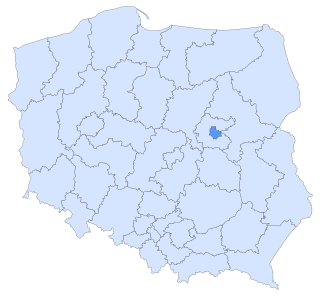
Warsaw I, officially known as Constituency no. 19, is one of the 41 constituencies of the Sejm, the lower house of the Parliament of Poland, the national legislature of Poland. The constituency was established as Constituency no. 1 in 1991 following the re-organisation of constituencies across Poland. It was renamed Sejm Constituency no. 19 in 2001 following another nationwide re-organisation of constituencies. It is conterminous with the city of Warsaw. Electors living abroad or working aboard ships and oil rigs are included in this constituency. The constituency currently elects 20 of the 460 members of the Sejm using the open party-list proportional representation electoral system. At the 2023 parliamentary election it had 1,993,723 registered electors.

Jan Krzysztof Ardanowski is a Polish politician, farmer and member of the Sejm since 2011. He served as the Minister of Agriculture and Rural Development between 20 June 2018 and 6 October 2020.

Senate Constituency no. 43 is a single-member constituency for the Senate of Poland comprising four districts of the city of Warsaw: Mokotów, Ursynów, Wawer and Wilanów. Incumbent senator is Małgorzata Kidawa-Błońska elected in 2023 parliamentary election. She serves as the Marshal of the Senate.

The Medal for Oder, Neisse and Baltic was a Polish commemorative medal awarded by the Polish People's Republic to commemorate those who directly participated in combat against the Nazi Germany for the liberation of Poland and the restoration of its old boundaries on the rivers the Oder, the Neisse and the coast of Baltic Sea.
The Polish Diaspora Day is a public holiday celebrated in Poland on 2 May, to commemorate the Polish diaspora around the world. It was established on 20 March 2002, by the Sejm of Poland, from the incitive of the Senate of Poland. It is celebrated on the same day as the Polish National Flag Day. It takes place a day after the International Workers' Day, and a day before the 3 May Constitution Day.
